From Sheperd Paine: The Life and Work of a Master Military Modeler and Historian by Jim DeRogatis (Schiffer Books, 2008)
J.D. You go outdoors for your next box, “The Remnants of an Army,” which really captures the cold and misery of Napoleon’s retreat from Moscow.
S.P. I wanted to do something from the retreat from Moscow, and the idea of the wolves’ eyes really appealed to me—that was the real reason for doing it. There’s a group of guys around a campfire, wearing a variety of different uniforms, because by that time, the unit cohesion had really broken up. As they see the wolves, one man is raising his musket, and another is reaching for his sword.
This box is 54mm because of the size of the scene: If I had done it in 100mm, the box would have been too big. As I’ve said, I try for an overall size similar to a breadbox, but here, there needed to be some distance between the campfire and the wolves. It was a relatively small idea, not like “The Night Watch” or the Victory, so I wanted it to be a reasonably sized box.
J.D. How did you do the campfire?
S.P. The same way I’d done the other flames—with fiberglass. I think it has two or three light bulbs in it to create more of an irregular contour and color.
J.D. Besides the fire and the wolves’ eyes, is there any other lighting?
S.P. I think there’s a main overhead light with a blue theatrical gel on it. My needs for colored gels were so small that I could often cut pieces out of the sample book, but for something like night blue, which I used any number of times, I bought a full sheet. I’d buy a medium density, because I could always double- or triple-layer it to make it more dense, but if it was too dense to begin with, there was no way to lighten it up.
The snow is just Celluclay painted white; I may have sprinkled some marble dust on it. The trees are mostly twigs, and I used a lot of what they call sheet moss: You buy it at the florist’s and dye it dark green, and it makes pretty good evergreens.
J.D. Again, there are a lot of details that take some time to soak in. Is that the skeleton of a horse?
S.P. Yes. Next to it you can see a hand and part of a lancer’s czapska sticking out of the snow.
J.D. And did you sculpt the wolves?
S.P The wolves originally started as German shepherds; I cast one, and converted the rest. I drilled holes in their heads, and then ran the fiber optics through from behind, then down a channel in their backs to hide the wires.
Jim Gibson bought this box. Jim was one of my first patrons, and when I was in my Historex stage, he bought almost everything I did, including “The Eve of Essling.” He had one of the best collections in the United States. Bill Horan bought the box from Jim’s estate a few years ago.
J.D. I remember Bill telling me he took it apart to figure out how to build a boxed diorama when he was doing his first, “Dawn Attack,” in 2005.
S.P. Oh yes—at that time I was getting daily phone calls from Bill! As I’ve said, one of the best things about the hobby is that everybody is willing to help each other out, and half the fun is sharing what you know. It’s a well-established tradition, and the only person I knew who wouldn’t share his techniques was quickly ostracized from the hobby.


